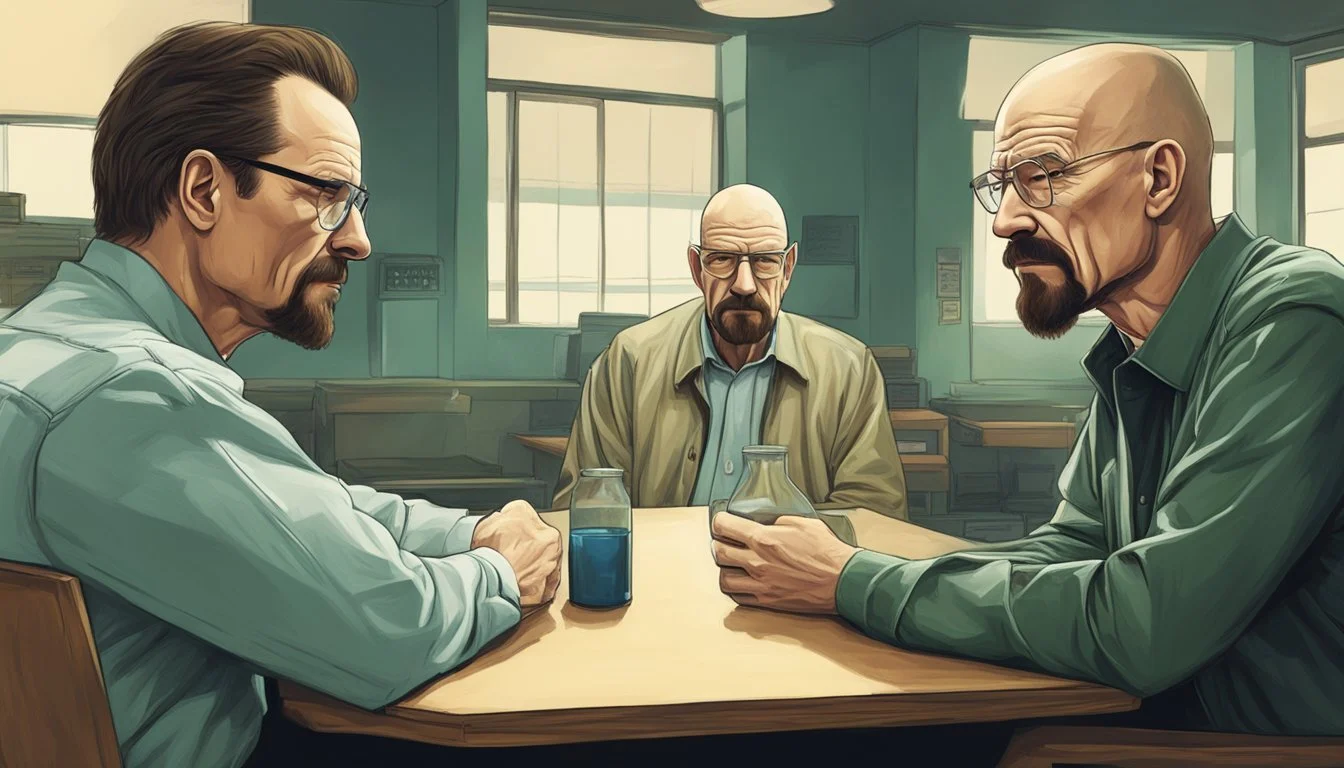Heisenberg's Uncertainty: Breaking Bad's Exploration of Alter Egos
A Character Study of Walter White
Breaking Bad's Walter White transforms into his alter ego Heisenberg, mirroring the uncertainty principle of his namesake. This duality explores the fluid nature of identity and morality in the face of extreme circumstances. Walter's journey from mild-mannered chemistry teacher to ruthless drug lord showcases how individuals can embody seemingly contradictory personas.
The show's creators cleverly chose the Heisenberg moniker, referencing the Nobel Prize-winning physicist Werner Heisenberg. This choice adds layers of meaning to Walter's character development and the show's themes. The uncertainty principle in quantum mechanics parallels the unpredictable nature of Walter's actions and the blurring lines between his two identities.
As Walter embraces his Heisenberg persona, viewers witness a gradual but profound change. This transformation challenges our understanding of human nature and the potential for drastic personal evolution. Breaking Bad invites us to consider how external pressures and internal desires can reshape an individual's core identity.
The Phenomenon of Breaking Bad
Breaking Bad captivated audiences with its gripping narrative and complex characters. The show's exploration of morality and transformation left an indelible mark on television history.
Series Overview and Impact
Breaking Bad premiered on AMC in 2008 and ran for five seasons. The series follows Walter White, a high school chemistry teacher turned methamphetamine manufacturer. Bryan Cranston's portrayal of Walter White earned critical acclaim and multiple Emmy Awards.
The show's innovative storytelling and character development set new standards for television drama. Breaking Bad's intricate plot twists and moral ambiguity kept viewers on the edge of their seats.
Its impact extended beyond entertainment, sparking discussions about the American healthcare system and the consequences of choices made under desperate circumstances.
Vince Gilligan's Creative Vision
Vince Gilligan, the creator of Breaking Bad, crafted a narrative that challenged conventional storytelling. His vision of transforming the protagonist from "Mr. Chips to Scarface" became the show's driving force.
Gilligan's attention to detail and commitment to authenticity elevated the series. He insisted on realistic portrayals of the drug trade and its consequences. This dedication to realism contributed to the show's credibility and immersive quality.
The series' visual style, with its distinctive use of color and symbolism, became a hallmark of Gilligan's creative approach.
Breaking Bad and its Cultural Significance
Breaking Bad transcended its status as a television show to become a cultural phenomenon. The series sparked conversations about morality, identity, and the human capacity for change.
The show's popularity led to a surge in tourism in Albuquerque, New Mexico, where it was filmed. Fans flocked to locations featured in the series, boosting the local economy.
Breaking Bad's influence extended to popular culture, inspiring memes, merchandise, and even a spin-off series, Better Call Saul. The show's iconic elements, such as Walter White's pork pie hat and the phrase "I am the one who knocks," became instantly recognizable cultural references.
Profile of Walter White
Walter White, a high school chemistry teacher who transforms into a notorious methamphetamine producer, stands as one of television's most complex characters. His journey from mild-mannered family man to criminal mastermind explores themes of morality, identity, and the human capacity for change.
Walter White: Chemistry Teacher Turned Meth Producer
Walter begins as an overqualified high school chemistry teacher in Albuquerque, New Mexico. His brilliant mind is wasted in this role, leaving him unfulfilled and struggling financially. A terminal lung cancer diagnosis becomes the catalyst for his dramatic life change.
Faced with mounting medical bills and a desire to secure his family's future, Walter turns to methamphetamine production. He leverages his chemistry expertise to create an exceptionally pure product, quickly gaining notoriety in the criminal underworld.
Walter's scientific background proves crucial in his new illicit career. He approaches drug manufacturing with the precision and methodology of a skilled chemist, setting his product apart in a competitive and dangerous market.
Character Transformation and Motivations
Walter's transformation is driven by complex motivations. Initially, he justifies his actions as necessary for his family's welfare. However, as he delves deeper into the criminal world, his reasons evolve.
Power and recognition become increasingly important to Walter. He relishes the respect and fear his alter ego commands, filling a void left by years of feeling underappreciated and powerless.
Walter's cancer diagnosis acts as both a motivator and an excuse. It provides urgency to his actions and serves as a moral shield, allowing him to rationalize increasingly unethical behavior.
His journey reflects a gradual erosion of moral boundaries. Each compromise and transgression paves the way for more significant breaches of ethics, illustrating the slippery slope of moral decay.
The Duality of Walter White and Heisenberg
The emergence of Walter's alter ego, Heisenberg, represents a critical aspect of his character development. This persona embodies the darker, more assertive traits that Walter had long suppressed.
Heisenberg becomes synonymous with confidence, ruthlessness, and criminal genius. The name, borrowed from a renowned physicist, reflects Walter's scientific background and his new identity's calculated nature.
The line between Walter White and Heisenberg blurs as the series progresses. What starts as a role Walter plays eventually becomes an integral part of his personality, showcasing the profound impact of his choices on his identity.
This duality creates internal conflict, as Walter struggles to reconcile his former self with his new reality. It raises questions about the nature of identity and the extent to which people can change while remaining true to their core selves.
Heisenberg's Uncertainty Principle and Alter Egos
The uncertainty principle in quantum mechanics shares intriguing parallels with the concept of alter egos in fiction. Both involve hidden aspects and a duality between what can be known or observed versus what remains concealed or unpredictable.
Theoretical Framework: Heisenberg and the Uncertainty Principle
Werner Heisenberg formulated the uncertainty principle in 1927, revolutionizing quantum physics. The principle states that certain pairs of physical properties, like position and momentum, cannot be precisely determined simultaneously.
As a particle's position becomes more defined, its momentum becomes less certain, and vice versa. This fundamental limit of precision challenges classical physics notions of determinism.
Heisenberg's groundbreaking work earned him the Nobel Prize in Physics in 1932. The principle remains a cornerstone of quantum mechanics, influencing modern physics and technology.
Heisenberg as Walter's Alter Ego
In "Breaking Bad", Walter White adopts "Heisenberg" as his alter ego. This nickname cleverly references the uncertainty principle, reflecting Walter's transformation.
Like the quantum particles described by Heisenberg's principle, Walter's true nature becomes increasingly uncertain as his "Heisenberg" persona grows more defined. The duality between Walter White and Heisenberg mirrors the wave-particle duality in quantum mechanics.
This alter ego allows Walter to explore hidden aspects of his personality, much like how the uncertainty principle reveals hidden properties of quantum systems.
Alter Egos and Their Roles in Fiction
Alter egos serve crucial roles in fiction, allowing characters to explore different facets of their personalities. They often represent suppressed desires or hidden talents.
Examples include:
Bruce Wayne/Batman
Clark Kent/Superman
Dr. Jekyll/Mr. Hyde
These alter egos create tension between public and private identities. They reflect the uncertainty inherent in human nature, echoing Heisenberg's principle in the realm of character development.
Alter egos also provide a narrative device for exploring themes of identity, morality, and the complexities of human behavior. They challenge readers to consider the multifaceted nature of personality and the potential for change within individuals.
Themes and Symbolism in Breaking Bad
Breaking Bad masterfully weaves complex themes and rich symbolism throughout its narrative. The show explores moral decay, identity transformation, and the consequences of choices through vivid imagery and character arcs.
Moral Ambiguity and Consequences
Walter White's journey from mild-mannered teacher to ruthless drug lord epitomizes the show's central theme of moral ambiguity. His initial noble intentions of providing for his family after a cancer diagnosis quickly spiral into a dark descent.
The series constantly challenges viewers to reassess their sympathies. Characters often blur the lines between right and wrong, forcing audiences to confront their own moral boundaries.
Actions have far-reaching consequences in Breaking Bad's universe. A single decision can trigger a devastating chain of events, affecting not just the characters but entire communities.
Symbolic Elements: The Porkpie Hat and Others
The iconic porkpie hat serves as a powerful symbol of Walter's transformation into his alter ego, Heisenberg. When donned, it signifies his shift from meek chemistry teacher to formidable meth kingpin.
Walt's meth-making process itself becomes symbolic. The purity of his product contrasts sharply with the moral decay it represents and causes.
Other symbols include:
The RV: Represents Walt and Jesse's initial venture into the drug world
The pink teddy bear: Foreshadows tragedy and innocence lost
Lily of the valley: Symbolizes Walt's manipulation and deceit
Color Theory and Its Usage
Breaking Bad employs a sophisticated color palette to convey character development and emotional states:
Green: Associated with greed and money
Yellow: Represents caution and the meth industry
Red: Signifies violence and danger
Blue: Linked to purity and Walter's signature product
Walt's wardrobe transitions from beige and khaki to darker tones as he embraces his Heisenberg persona. This visual cue subtly reinforces his character's evolution.
The stark New Mexico landscape serves as a canvas for these color choices, amplifying their impact and creating a visually striking world.
Supporting Characters and Their Arcs
Breaking Bad's supporting characters undergo significant transformations alongside Walter White. Their evolving relationships and personal journeys add depth and complexity to the series' narrative.
Jesse Pinkman: The Troubled Protégé
Jesse Pinkman starts as Walt's former student and becomes his partner in the meth business. Initially portrayed as a small-time drug dealer, Jesse develops into a complex character with a strong moral compass.
His relationship with Walt is tumultuous, marked by loyalty, betrayal, and manipulation. Jesse struggles with addiction and guilt throughout the series, particularly after Jane's death and Gale's murder.
Jesse's arc involves attempts to break free from the drug world and find redemption. His interactions with children, like Brock, highlight his underlying compassion and desire for a normal life.
Skyler White and Family Dynamics
Skyler White evolves from a loving wife to a reluctant accomplice in Walt's criminal activities. Her initial shock and opposition gradually give way to pragmatic involvement in money laundering.
Walt Jr. and Marie are caught in the crossfire of Walt's descent into criminality. Walt Jr. grapples with his father's true nature, while Marie's kleptomania and relationship with Hank add layers to the family drama.
The White family's disintegration mirrors Walt's moral decay. Skyler's increasing isolation and fear for her children's safety drive her to make difficult choices, showcasing the far-reaching consequences of Walt's actions.
Antagonists and Allies: Gus, Mike, and Saul Goodman
Gus Fring emerges as a formidable adversary, presenting a facade of a legitimate businessman while running a drug empire. His meticulous planning and ruthlessness make him a worthy opponent for Walt.
Mike Ehrmantraut, Gus's right-hand man, becomes a reluctant ally to Walt and Jesse. His pragmatic approach and loyalty to Gus create tension and conflict within the criminal underworld.
Saul Goodman, the colorful criminal lawyer, provides comic relief and crucial legal maneuvering. His connections and questionable ethics make him an essential part of Walt's operations.
These characters' arcs intersect with Walt's, creating a complex web of alliances, betrayals, and power struggles that drive the series' thrilling narrative.
Plot Twists and Noteworthy Episodes
Breaking Bad's narrative is punctuated by shocking plot developments and memorable episodes that showcase Walter White's transformation into Heisenberg. These pivotal moments reveal the depths of his moral descent and the consequences of his actions.
Defining Moments in Breaking Bad
The fulminated mercury explosion in Tuco's office marks a turning point for Walter, demonstrating his willingness to use chemistry as a weapon. This bold move establishes his alter ego's ruthlessness and cunning.
Walter's first encounter with Gus Fring sets the stage for a complex rivalry. Their initial meeting in Los Pollos Hermanos appears mundane but carries weighty implications for the story's trajectory.
The ricin storyline recurs throughout the series, highlighting Walter's calculating nature. Its various uses and near-misses create tension and underscore the dangers of his double life.
Analysis of Season 4 Climax
Season 4's finale, "Face Off," delivers a masterclass in tension and payoff. Walter's scheme to eliminate Gus using a pipe bomb attached to Hector Salamanca's wheelchair is a pinnacle of his strategic thinking.
The lead-up to this moment involves intricate maneuvering, with Walter leveraging long-standing grudges and exploiting weaknesses. Gus's death scene, with half his face blown off, becomes an iconic image of the series.
This climax reshapes the power dynamics of the show. Walter's victory over Gus solidifies his position as the primary antagonist, fully embracing his Heisenberg persona.
Impact on Television and Spin-offs
Breaking Bad's exploration of alter egos revolutionized television storytelling. The show's success paved the way for complex character studies and morally ambiguous protagonists.
Breaking Bad's Legacy in TV History
Breaking Bad redefined the antihero archetype in television. Walter White's transformation into Heisenberg captivated audiences and critics alike. The show's expert blend of dark humor, intense drama, and character development set a new standard for serialized storytelling.
AMC's risk in backing the series paid off, establishing the network as a home for high-quality original programming. The show's critical acclaim and devoted fanbase demonstrated the appetite for sophisticated, long-form narratives on television.
Breaking Bad's influence extends beyond its own run. It inspired a wave of morally complex protagonists and raised the bar for production values in television dramas. The series' success also highlighted the potential of lesser-known actors like Bryan Cranston in lead dramatic roles.
The World Beyond - Better Call Saul and El Camino
Breaking Bad's universe expanded with two successful spin-offs. Better Call Saul, focusing on lawyer Saul Goodman's origin story, proved the strength of the show's secondary characters. Set in Albuquerque, it maintained the original series' high production standards and nuanced character development.
El Camino, a feature-length film, continued Jesse Pinkman's story after the events of Breaking Bad. These spin-offs demonstrated Vince Gilligan's ability to create compelling narratives within the same universe.
Both projects retained Breaking Bad's signature style while exploring new themes. Better Call Saul delved deeper into the legal world of Albuquerque, while El Camino provided closure for fans invested in Jesse's fate.
The success of these spin-offs underscores Breaking Bad's lasting impact on television. They expanded the show's legacy and kept its universe alive for fans long after the original series concluded.
Real-Life Parallels and Educational Insights
Breaking Bad explores themes of education, chemistry, and societal issues through its protagonist Walter White. His transformation from high school chemistry teacher to methamphetamine kingpin reflects complex real-world dynamics.
Chemistry and Education in Breaking Bad
Walter White's background as a high school chemistry teacher plays a crucial role in his descent into the drug world. The show highlights how his expertise in chemistry enables him to produce high-quality methamphetamine.
This storyline raises questions about the potential misuse of scientific knowledge. It also sheds light on the challenges faced by educators in the U.S. public school system.
Walter's initial motivation - funding his cancer treatment - reflects real-world healthcare issues. This plot point resonates with viewers familiar with the financial burdens of serious illnesses.
The Societal Reflection of Drug Culture
Breaking Bad offers a stark portrayal of the methamphetamine epidemic in the United States. It depicts the devastating effects of drug abuse on individuals, families, and communities.
The show illustrates the complex web of drug production, distribution, and enforcement. It showcases the challenges faced by drug enforcement agencies in combating illegal narcotics.
Walter's transformation into "Heisenberg" mirrors real-life cases of seemingly ordinary individuals becoming involved in criminal activities. This storyline explores the blurred lines between lawful and unlawful behavior in desperate circumstances.
The series also examines the socioeconomic factors that can drive people towards illegal activities. It presents a nuanced view of the drug trade's impact on different social strata.
Character Development Strategies
Breaking Bad employs masterful techniques to transform Walter White from a sympathetic protagonist into a complex antagonist. The show's writers craft a nuanced journey that explores the depths of human nature and moral decay.
Writing Techniques for Evolving Characters
Character development in Breaking Bad hinges on gradual change and pivotal moments. Walter White's transformation unfolds through subtle shifts in behavior and dialogue. The writers use contrasting scenes to highlight his evolution, juxtaposing his early meekness with later displays of ruthlessness.
Flashbacks provide insight into Walter's past, revealing his relationships with Gretchen and Elliott Schwartz at Gray Matter. These glimpses inform his present motivations and resentments.
The show also employs visual cues to mark Walter's progression. His appearance changes as he embraces his Heisenberg persona, symbolizing his internal metamorphosis.
From Protagonist to Antagonist: Walter White's Journey
Walter White's descent into villainy is carefully crafted to maintain audience engagement. The writers initially present him as sympathetic, facing a terminal diagnosis and financial struggles. His early actions seem justified, rooted in desperation to provide for his family.
As the series progresses, Walter's choices become increasingly morally ambiguous. His interactions with Jesse, Skyler (played by Anna Gunn), and his criminal associates reveal a growing hunger for power and recognition.
Key moments punctuate Walter's transformation:
Allowing Jane's death
Poisoning Brock
Ordering prison murders
These acts mark significant milestones in Walter's journey from protagonist to antagonist, challenging viewers' loyalty and moral compass.




